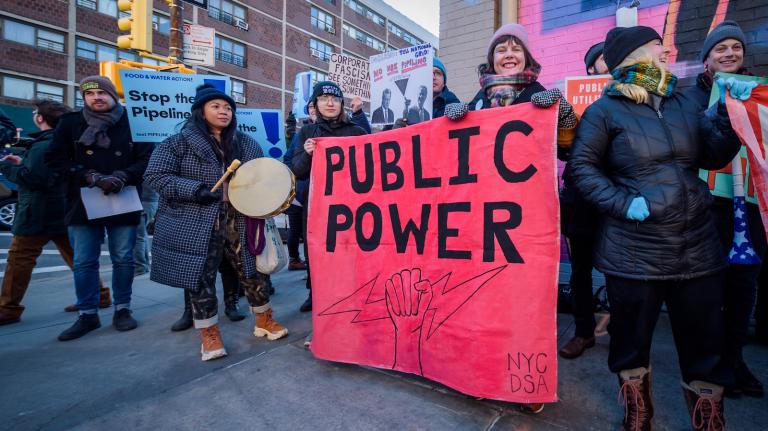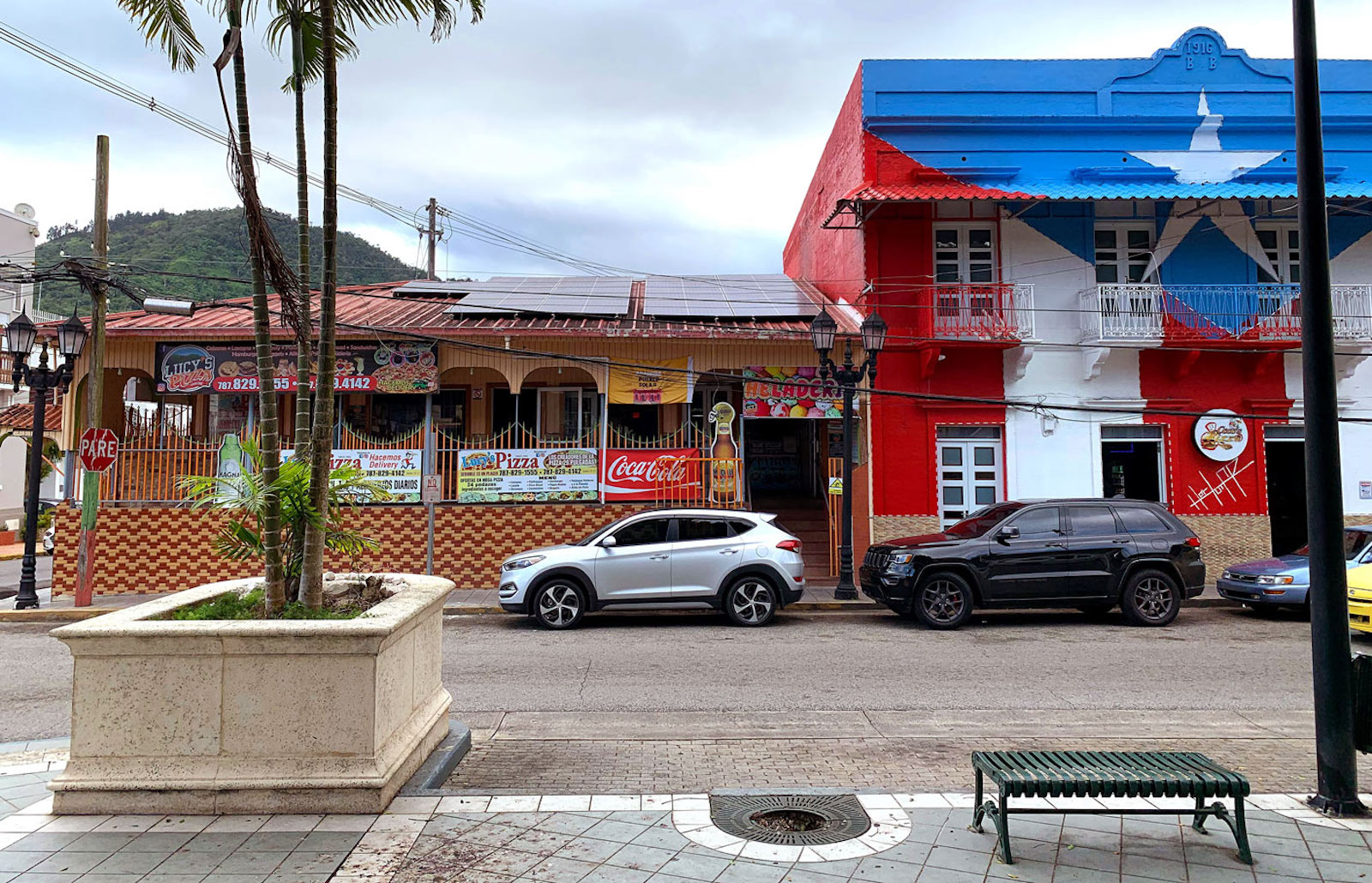This story was originally published by Canary Media.
Lee este artículo en español aquí.
A bright yellow building with bold green trim hums with activity in Caguas, a city sprawled across a mountain valley south of San Juan, Puerto Rico. In a spacious kitchen, volunteers chop vegetables and cook rice for community meals. Down the hall, visitors browse racks of free and discounted produce, canned beans, and bottles of oil. Outside, beneath a large metal awning, retirees soak in calming music as they take part in a stress-relief workshop.
The community services on offer here at the Centro de Apoyo Mutuo, or Mutual Support Center, are made possible by the 24 solar panels mounted on the rooftop. Two lithium-ion batteries the size of suitcases are kept in a windowless storage room, allowing the center to stay open on cloudy days and in the evenings. The building doesn’t use any electricity from the utility grid.
Nearly five years ago, after Hurricane Maria tore a path of devastation across the United States territory and all but destroyed Puerto Rico’s electricity system, residents in Caguas reclaimed what had for decades been an abandoned Social Security office. They ripped out moldy carpet, scrubbed the walls and began providing food and supplies to neighbors.
“This was a space that wasn’t serving the people, and now the community has taken it over,” Marisel Robles, one of the center’s organizers, says on a muggy day in early May, just weeks before the start of the next Atlantic hurricane season.
Robles guides me up a thin metal ladder to the rooftop of the one-story building, pushing aside tree branches sagging with brown seed pods. Saúl González, a volunteer and local solar installer, joins our expedition. The three rows of solar panels form a “mosaic” of different makes and models, all of them donated by nonprofit organizations, he explains.

With 6 kilowatts of solar capacity and 30 kilowatt-hours of battery storage, the system can typically meet the center’s power needs. Occasionally, members cut the lights and fans during the day to save electricity for an evening dance class. Still, Robles says it’s better than running expensive, polluting diesel generators or depending on the island’s electric grid — which, despite years of post-hurricane repairs, remains prone to routine outages, sweeping blackouts, and frequent voltage surges that fry people’s appliances. In early April, the entire island lost grid power for three days after an aging electric breaker caught fire on the southern coast.
“Sometimes, we hear the ‘boom’ of people turning on their diesel generators, and that’s how we know the power went out in town, because here we still have power,” Robles says, looking out over the tops of neighboring buildings. “For us, it’s like a victory every day this happens, because we feel like we did something right.”
The Mutual Support Center is not unique in its ability to produce its own clean energy. A rising number of Puerto Ricans are installing solar panels and batteries on their homes and businesses, fed up with the unstable electric grid, high electricity bills, and the state-owned utility’s reliance on fossil fuels. As of January 2022, some 42,000 rooftop solar systems were enrolled in the island’s net-metering program — more than eight times the number at the end of 2016, the year before Hurricane Maria struck the island, according to utility data. Thousands more systems are operating but are not officially counted because, like the center’s unit, they aren’t connected to the grid.
Spearheaded largely by residents, business owners, and philanthropies, the grassroots solar movement sweeping the island is happening despite headwinds from the territory’s centralized utility — which claims it’s working to advance the island’s clean energy goals but continues investing in fossil fuels. Solar proponents say that, for the technology to reach most of Puerto Rico’s 3.2 million people, the government and its utility will need to more fully participate in what has largely been a bottom-up energy transformation. With billions of federal recovery dollars set to flow to Puerto Rico, they argue that now is the time for public policies and investments that shift the island away from an outdated model of large, far-flung power plants to one that supplies clean electricity close to where people need it.
The vulnerability of Puerto Rico’s centralized system became painfully evident in September 2017, when the island was hit by two consecutive disasters.
Hurricane Irma narrowly skirted the island on September 7, leaving more than a third of all households without power. Many residents still didn’t have electricity when, on September 20, Hurricane Maria barreled ashore. The storm carved a diagonal 100-mile path from southeast to northwest, mowing down the island’s transmission lines and inundating infrastructure. Maria damaged, destroyed or otherwise compromised 80 percent of the island’s grid.
Without electricity, daily life ground to a halt. Schools shuttered, banks closed, supermarket food spoiled, and drinking water supplies slowed to a trickle. One study estimated that more than 4,600 people died as a result of the storm, including those who couldn’t operate their oxygen machines, refrigerate vital medications like insulin, or stay sufficiently cool in the sweltering heat. In some places, power wasn’t restored for more than a year after the hurricane.
“Maria made life very difficult. It was like a new beginning for many of us,” recalls Atala Pérez, who lives in Caguas and volunteers at the Mutual Support Center.
Pérez says she went more than six months without any electricity in her home. With no fan or air conditioner, she spent many restless nights in the sticky heat, slapping away mosquitos. Tired of waiting in line for eight hours to buy a bag of ice, she grew used to drinking tepid tap water. She could still cook but couldn’t keep any food in the refrigerator. “I didn’t have any backup power,” she says, standing inside the yellow building’s makeshift supermarket. “I was simply without electricity, and I had to adapt.”
The ferocity of Hurricane Maria would’ve battered any electric grid. But Puerto Rico’s power system was uniquely unprepared for the disasters that struck.
After years of economic recession, the island’s government had amassed $72 billion in debt. The Puerto Rico Electric Power Authority, or PREPA, the state-owned utility, had filed for bankruptcy months earlier. The economic crisis compounded decades of documented missteps, neglect, and ill-advised practices at PREPA. With its workforce slashed in half, the utility had delayed routine maintenance. Warehouses that should’ve stored spare equipment for use in emergencies instead had empty shelves.
In Maria’s aftermath, the U.S. Federal Emergency Management Agency allocated $3.2 billion to restore power to the island. Utility crews worked tirelessly to install concrete towers where wooden poles had snapped like twigs and to string up wires where old ones lay entangled on the ground. Yet the problems that plagued Puerto Rico before the storms — mismanagement, corruption, the island’s challenging geography — ultimately served to slow and complicate recovery efforts. Much of the work since Maria has focused on resurrecting and extending the life of the existing grid.
In 2020, Puerto Rico signed a 15-year deal that transferred the publicly operated transmission and distribution system to Luma Energy, a private consortium of Canadian and U.S. companies that now operates the grid and handles reconstruction. PREPA remains in charge of producing and procuring electricity.
In its latest quarterly report, Luma said it made significant improvements in the first three months of this year, replacing hundreds of aging utility poles and enrolling more than 21,000 rooftop solar customers in net metering, a program in which utilities pay solar-equipped households for the electricity their panels supply to the grid.
Nonetheless, the consortium is facing widespread backlash from residents, who blame it for rising electricity bills and continued outages. In San Juan, thousands of protestors have marched past Luma’s headquarters and the governor’s mansion holding signs declaring “Fuera Luma” or “Out with Luma.” Similar posters are plastered on billboards near Luma’s office in Mayagüez, on the island’s western coast.
For many Puerto Ricans, rooftop solar systems offer a way out of an endless cycle of disruptions and disappointment. Energy experts estimate that thousands of new solar arrays are hooked up every month. As of January, households in particular had installed at least 225 megawatts of combined solar capacity, equal to about 5.5 percent of total residential electricity demand, according to a recent report.
“The transformation is happening at a scale that is very satisfying to see,” says Arturo Massol Deyá, a professor at the University of Puerto Rico who co-authored the report and the executive director of Casa Pueblo, a community organization that helps people access solar power.
“We call this an energy insurrection,” he adds. “Even though in California and other states, you have incentives to help people [go solar], in Puerto Rico, we don’t. And yet people are doing it here because we’re confronting climate change in a hard way, and we’re confronting a utility that people can’t rely on.”
One of the most striking examples of the bottom-up transformation of Puerto Rico’s energy landscape can be found in Adjuntas, a tranquil town that sits high up in the island’s central mountain range. Casa Pueblo is located here, in a stately pink building near the town’s main square. The organization installed solar panels on its rooftop in 1999 and is now spearheading a first-of-its-kind community-scale solar initiative.
Over a dozen businesses near the palm-tree-studded plaza put solar panels on their rooftops last year, totaling about 200 kilowatts in capacity. This August, they’ll also install a total of 1 megawatt-hour of battery storage capacity. Participants will share the solar electricity they produce and draw from the interconnected batteries, which tie the installations together like a mini power plant.
Gustavo Irizarry, the owner of Lucy’s Pizza, slides into a yellow dining booth on a recent cool and quiet evening. His unassuming pizzeria hugs a corner of the main square, its rooftop solar panels visible from the sidewalk.
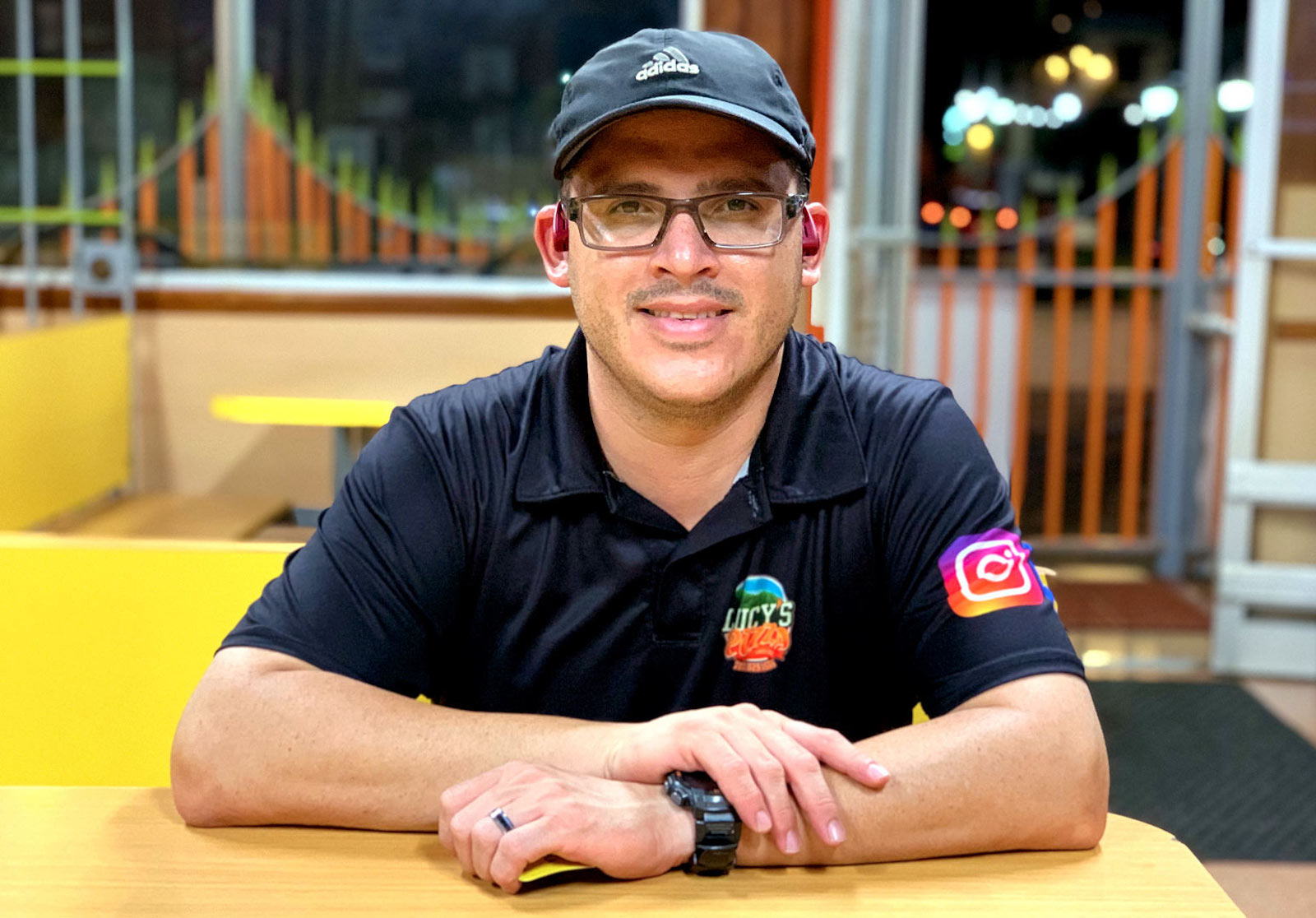
When he’s not running the shop or ferrying pizzas along steep, winding roads, Irizarry leads the Community Solar Energy Association of Adjuntas. The group, in a sense, acts like a utility. Participating businesses pay a fixed monthly rate for the solar electricity they consume. The association uses that money to cover the project’s operation and maintenance costs, and also to help lower-income families and rural stores to install their own solar-and-battery systems.
“The hardest part is explaining this philosophy to people in the business community, who compete with one another or who plan to retire in a few years,” says Irizarry, who, at 39, is the association’s youngest member. “My role is to convince them that what we’re doing will help our planet and our people last longer.”
Lucy’s Pizza served as a safe haven during Hurricane Maria, when massive landslides buried highways and complicated relief efforts in Adjuntas. For weeks, it was the only place in the isolated town of 18,000 people where residents could get a warm meal or charge electronics. Irizarry says the shop spent around $17,000 during that period just to fill its generators with diesel fuel, which was hard to find on the supply-constrained island.
The community-scale solar system should enable businesses to keep their lights on for at least a week if the utility grid goes down again. “Our mission is to be able to cover people’s basic needs during a catastrophe, so that they can come to us to get food, ice, charge their phones [and] their medical equipment, and get internet,” Irizarry explains as hungry customers trickle past us. A cashier calls out names over the loudspeaker, sliding warm takeout boxes over the counter.
Grid operator Luma Energy isn’t involved in the project, but it hasn’t interfered either, participants say. However, many other partners are contributing to the effort. The U.S.-based Honnold Foundation has led a $1.7 million investment in the project, an amount that includes donated panels and batteries, electrical contracting work and technical support, says Cynthia Arellano, the foundation’s project manager for the Adjuntas initiative.
Engineers from the University of Puerto Rico and the U.S. Department of Energy’s national laboratories are helping to fine-tune the software programs and electronic controls that will do the unseen work of managing electricity flows between the businesses. Experts from both institutions are studying the project closely to see how the system might be replicated in other towns and regions across the island.
“If you start sharing energy between all your neighbors, you can create these kinds of solutions and get stronger against the next hurricane,” says Fabio Andrade, an associate professor at the University of Puerto Rico’s campus in Mayagüez.
Andrade heads the university’s Microgrid Laboratory, which is helping to develop the Adjuntas initiative, as well as two small microgrid projects in the communities of Maricao and Castañer. While the term “microgrid” is often used broadly to describe any small-scale electricity system with storage — such as solar panels and batteries — the concept more accurately refers to a group of interconnected systems, he says. Together, these systems can hook up to the grid, supplying electricity and also using utility power when the grid is working well. Crucially, microgrids can detach and operate independently when disruptions occur.
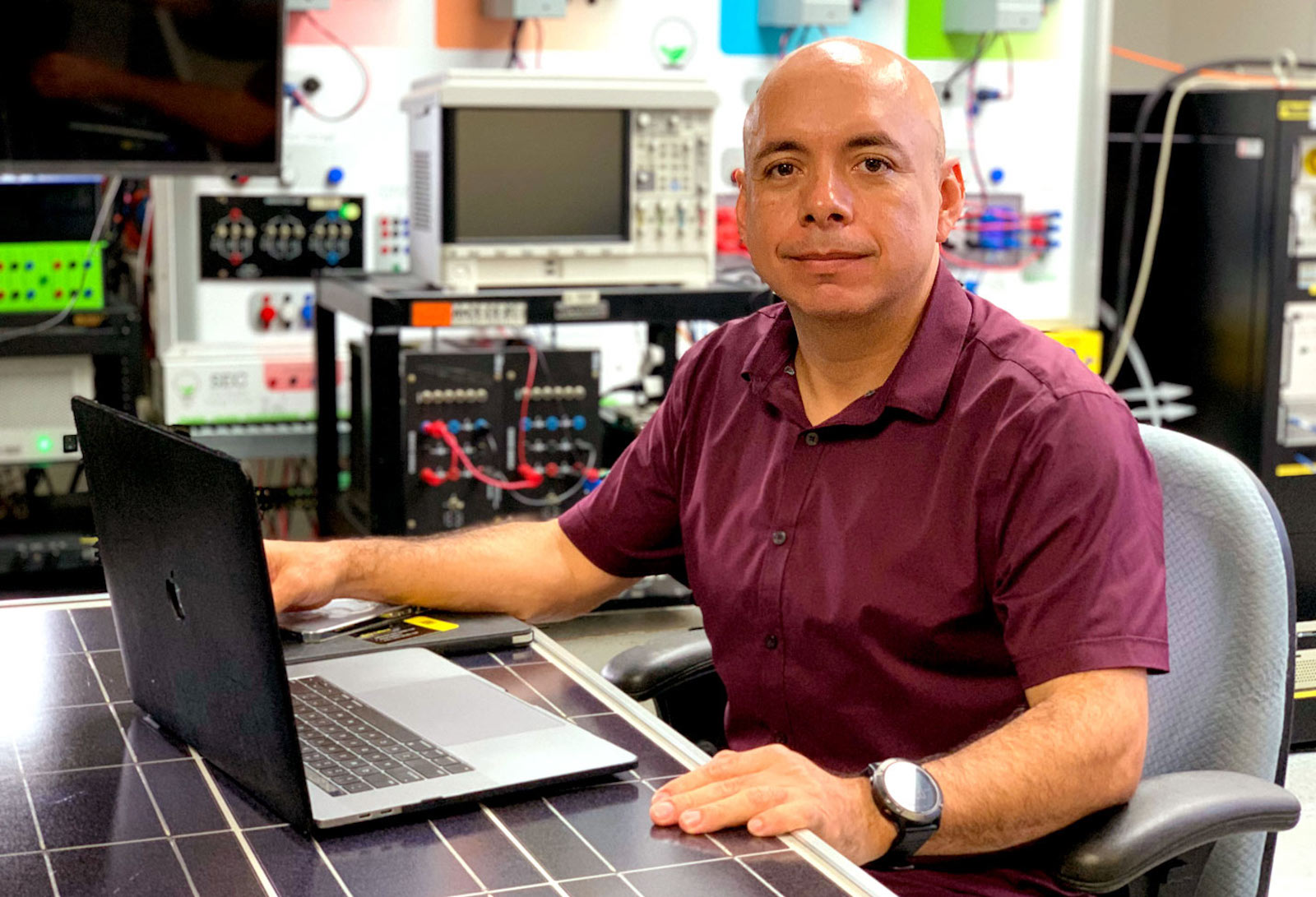
Since Hurricane Maria, researchers and policymakers in Puerto Rico and the U.S. mainland have called for building resilient microgrids across the island to support — or potentially even supplant — the centralized electricity system. In a room tucked inside a faded green Cold War–era building, Andrade and student researchers experiment with different microgrid scenarios. They replicate the flow of power from wind turbines, solar panels, electric car batteries and the main grid and analyze how microgrids might respond to rising voltage levels, errant frequencies, or shrinking or surging power supplies.
“We need to understand how all of this is working,” Andrade says, adding that his research draws from his own experience of living without power for three months after Hurricane Maria.
“Microgrids can give you the minimum electricity you need for survival,” he says.
The Puerto Rican government has taken some steps to help realize this vision of cleaner, more resilient power. The Puerto Rico Energy Bureau, which regulates the island’s energy system, recently adopted rules allowing microgrids to connect to the main grid. Other reforms ostensibly make it easier and faster for individuals to enroll their rooftop solar systems in net metering.
Nevertheless, the island has far more work to do to achieve its mandate of 100 percent renewable energy by 2050, which the governor’s office set in 2019. Only about 5 percent of the island’s electricity comes from renewable sources. Petroleum is the grid’s largest fuel source, representing 48 percent of electricity generation in April. Puerto Rico’s reliance on imported diesel has led to surging electricity bills in recent months as global oil prices climb. That fuel, along with the island’s gas and coal plants, continues contributing greenhouse gases and pumping harmful air pollution into communities.
In March, after lengthy delays, regulators conditionally approved 884 megawatts’ worth of large-scale renewable energy projects, which should raise the island’s total share of renewables to 23 percent by the end of 2024. Officials have said they’re working to accelerate the slow-moving permitting process to meet Puerto Rico’s near-term goal of achieving 40 percent renewables by 2025.
At the same time, though, Puerto Rico is expanding its investments in fossil fuel infrastructure.
In 2019, PREPA awarded U.S. company New Fortress Energy a $1.5 billion contract to convert two oil-burning power plant units in San Juan from petroleum to gas. The deal also included building an import terminal for liquefied natural gas, which began operating in San Juan’s harbor in 2020 — before the U.S. Federal Energy Regulatory Commission had authorized the project. Last year, the commission ordered New Fortress to retroactively apply for a permit, though the gas company is pushing back in court.
Puerto Rican officials have said converting the San Juan units to gas provides cleaner, cheaper fuel for the grid. Energy experts and environmentalists who oppose the contract say investing in new fossil fuel infrastructure only detracts from the government’s goals to curb emissions and improve resiliency.
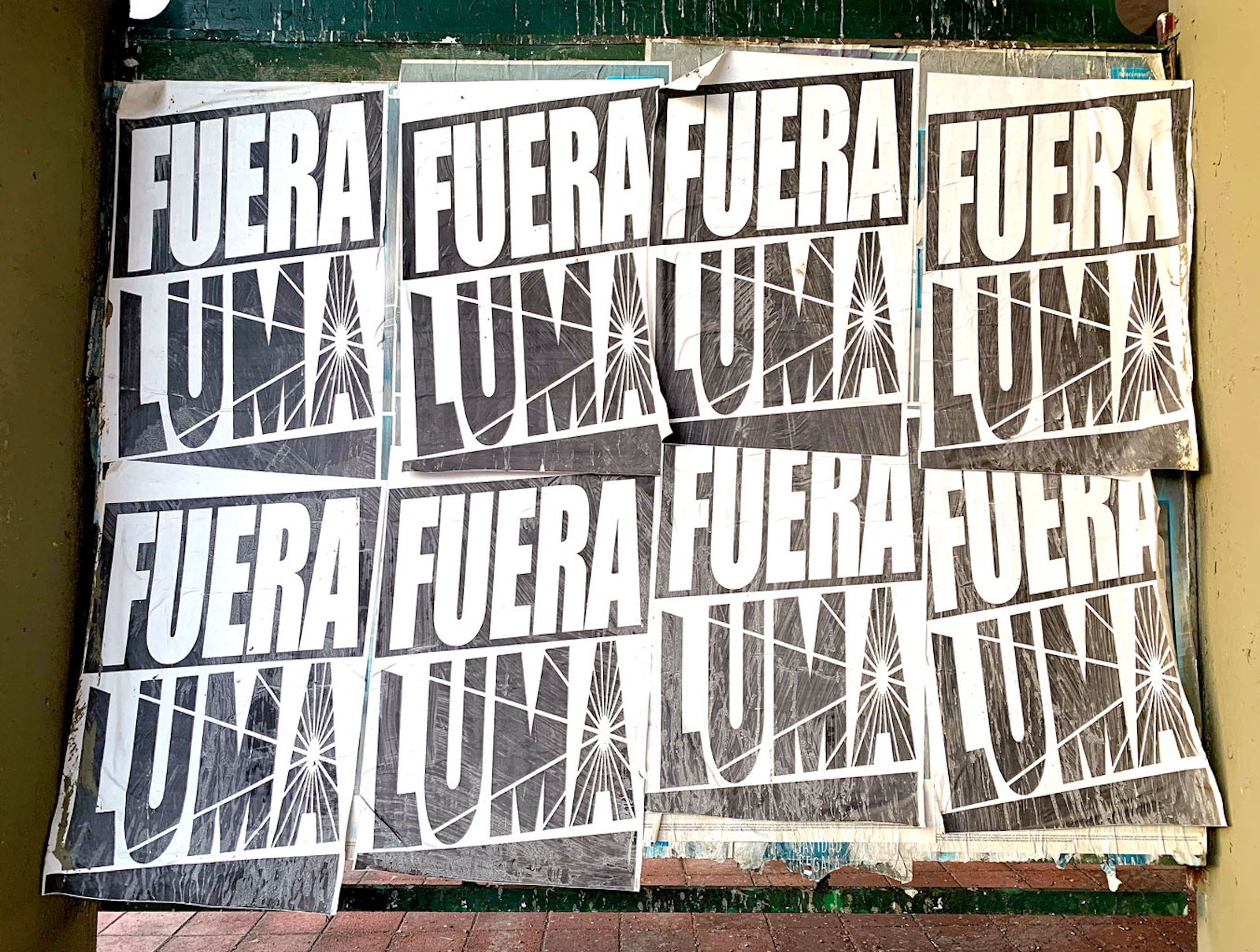
“We’re in a climate crisis that’s growing worse every day,” says Daniel Muñoz, a homeowner in University Gardens, a quiet neighborhood of one-story houses in San Juan. “Our generation, we should make the change [to renewable energy] now, because if not, the crisis will become a total disaster.”
Last year, Muñoz banded together with 21 of his neighbors to put solar panels and batteries on their individual houses. The systems aren’t tied together as in a microgrid. But by negotiating as a group, the neighbors secured a discount of roughly 20 percent with a local solar installer, shaving thousands of dollars off the cost of each installation.
Muñoz and his neighbor Victor Santana take me up to Santana’s rooftop to see the 26 blue solar panels installed there. Santana leads the neighborhood association and helped organize the collective solar effort. He says he paid $27,000 for the solar panels and two lithium-ion batteries, which can cover all of his household’s energy needs.
The University Gardens project is the first of its kind in Puerto Rico, though hundreds of communities on the U.S. mainland have negotiated similar bulk-purchase discounts with the help of nonprofit Solar United Neighbors. The Washington, D.C.-based organization recently partnered with Cambio, an environmental group in San Juan, to guide Santana, Muñoz, and their neighbors through the solar-buying process.
“We wanted to help improve the environment and also make our community a little more resilient,” Santana says over the din of squawking — vibrant green parrots called cotorras bounce up and down in a nearby tree. So far, his solar setup has spared him from two major blackouts: the islandwide outage that occurred in April and another disruption that swept San Juan last year after a fire broke out at the city’s Monacillos substation.
Now the homeowners say they want to help organize a second bundled solar purchase for other neighbors, particularly older, retired residents living on fixed incomes and grappling with rising electricity bills.
In Puerto Rico, some 43 percent of people live in poverty, according to the U.S. Census Bureau. The Covid-19 pandemic has further exacerbated widespread unemployment in the tourism-dependent economy. In the absence of a robust public policy facilitating access to clean energy, groups like the University Gardens neighbors are working to share their resources with residents who otherwise can’t afford to install their own rooftop solar systems.
“Right now, only well-off people and industries can get their own localized generation, and the majority of people can’t,” says Ruth Santiago, an environmental attorney who lives in the south coast city of Guayama and serves on the White House Environmental Justice Advisory Council. “This is very much a social justice and equity issue.”
Energy access isn’t just about enabling people to produce power at home. It’s also about improving the resilience of essential services, especially in the face of the worsening impacts of climate change.
Sergeant Luis Saez leads the fire department in Guánica, a sunbaked city near the turquoise waters off Puerto Rico’s southwest coast. Firefighters serve the municipality of some 16,000 people and respond to calls on the tourist-packed beaches and in the dry forest, where thousands of fires erupt every year. The Guánica station also connects far-flung units in remote towns to larger urban stations with more trucks and firefighters.
“Our whole computer dispatch system, telephone system, radio communications — all of that needs power,” Saez says. “If we don’t have communications, we can’t do our jobs.”

The sergeant steps into the garage where, beside the big red fire engine, four Tesla Powerwalls are attached to the wall. The lithium-ion batteries store electricity from the 52 solar panels sprawled across the building’s rooftop. Should the clouds roll in and the grid go down, the station’s essential systems could run just on battery power for about a week, he says.
Firefighters couldn’t receive calls immediately after Hurricane Maria, so they had to patrol the area looking for emergencies or wait for people to walk in. A similar scenario unfolded in January 2020 after a series of earthquakes left Puerto Ricans in the dark for days. Guánica was near the epicenter of one of them — a magnitude-6.4 earthquake that seriously damaged Puerto Rico’s largest power plant, an oil and gas-burning facility located just down the coast.
“There was no power, so we didn’t know where to go,” Saez recalls. Across from the fire station looms a forested hill with a deep scar from where a chunk of earth collapsed. “We just started seeing where people screamed and where people needed us. That was a bad moment.”
The Guánica station’s solar-and-battery system replaces the few small diesel generators that firefighters previously used in emergencies. Solar Responders, a nonprofit organization, helped install and maintain the system using a $277,000 grant from AbbVie, a pharmaceuticals manufacturer in Puerto Rico. Fifteen other fire stations have similar systems, though the nonprofit aims to put solar panels and batteries in all of the island’s 96 stations, says Hunter Johansson, the founder and CEO of Solar Responders.
There’s no doubt that Puerto Rico’s rooftop-solar movement is enabling many houses and facilities to avoid persistent outages and become more resilient in the face of disasters. But solar advocates emphasize that the current approach isn’t enough to meet the energy challenges facing the island.
“What people are doing now is…voting with their feet, so to speak,” says Agustín Irizarry, a professor at the University of Puerto Rico who works with the Microgrid Laboratory in Mayagüez (and has no relation to Gustavo Irizarry of Lucy’s Pizza).
“They are installing the systems themselves. And that’s a problem,” the professor says. “If we do this collectively, by investing the public money wisely, it will be cheaper for everyone. And the poor will have access to it as well.”
Earlier this year, the Biden administration reached a deal with Puerto Rico Governor Pedro Pierluisi, a Democrat, that will steer $12 billion in federal recovery funds to help modernize the outdated electric grid and move toward renewable energy, in line with the territory’s goals of getting to 100 percent renewables by 2050.
For Irizarry and other experts, the federal funding represents a crossroads for Puerto Rico’s energy future. As they see it, if the majority of those dollars are spent resurrecting transmission towers and building more far-flung power plants — even those powered by the wind and sun — then the island will have missed an opportunity to create a more nimble system dominated by local power generation.
Santiago, the environmental attorney, argues that the public utility PREPA should use much of that $12 billion to install solar panels and storage systems on buildings. The utility would still charge customers for the electricity they consume, except that the power would come from distributed systems instead of fossil fuel power plants. The idea is that “people continue to pay their bills, but they have access to resilient, locally sited renewable energy that doesn’t depend on transmission,” she says. “That’s the only way we see that most low and middle-income people will have access to these systems.”
More high-level participation in local solar development would also allow utility planners, regulators, and communities to install systems more strategically, creating interconnected microgrids that serve entire neighborhoods or regions, instead of only individual buildings. “If you coordinate this from the very beginning and make sure that all the equipment can talk to each other, it requires less investment,” Irizarry says.
Until that happens, however, groups like the Adjuntas business association and University Gardens neighbors are left to create ad hoc solutions that expand access to clean energy to those who can’t afford it.
Back in Caguas, the Mutual Support Center is already supplying solar electricity to its neighbor. Standing on the yellow building’s rooftop, Marisel Robles and Saúl González point to a small cultural museum across a common courtyard. The center’s solar panels can connect by wire to the museum, keeping its lights on whenever the center produces more electricity than it needs.
“In Puerto Rico, right now the model for moving to renewable energy is, save yourself if you can, or save yourself if you have the resources,” González says. “We’re trying to see how we can change that situation.”

